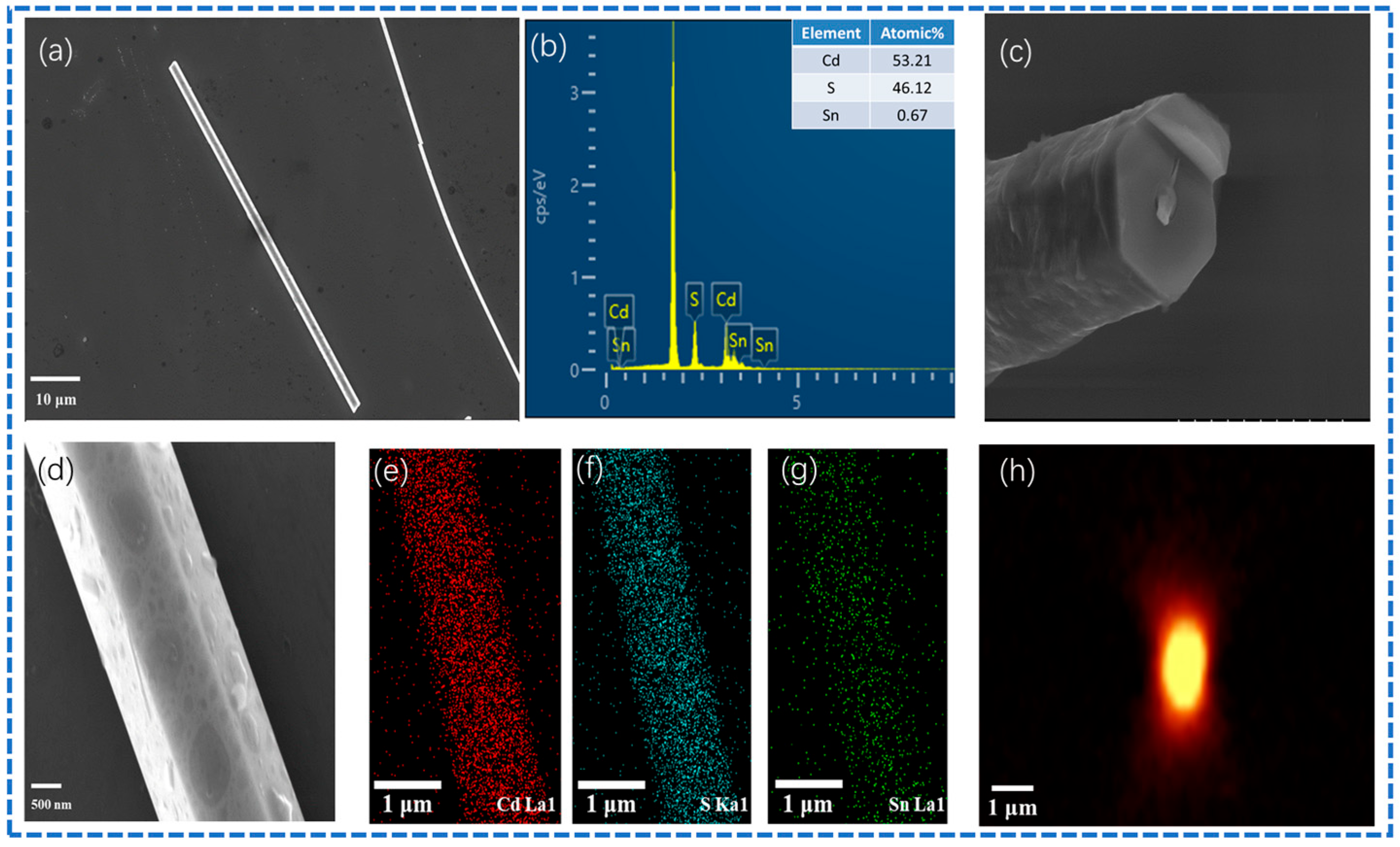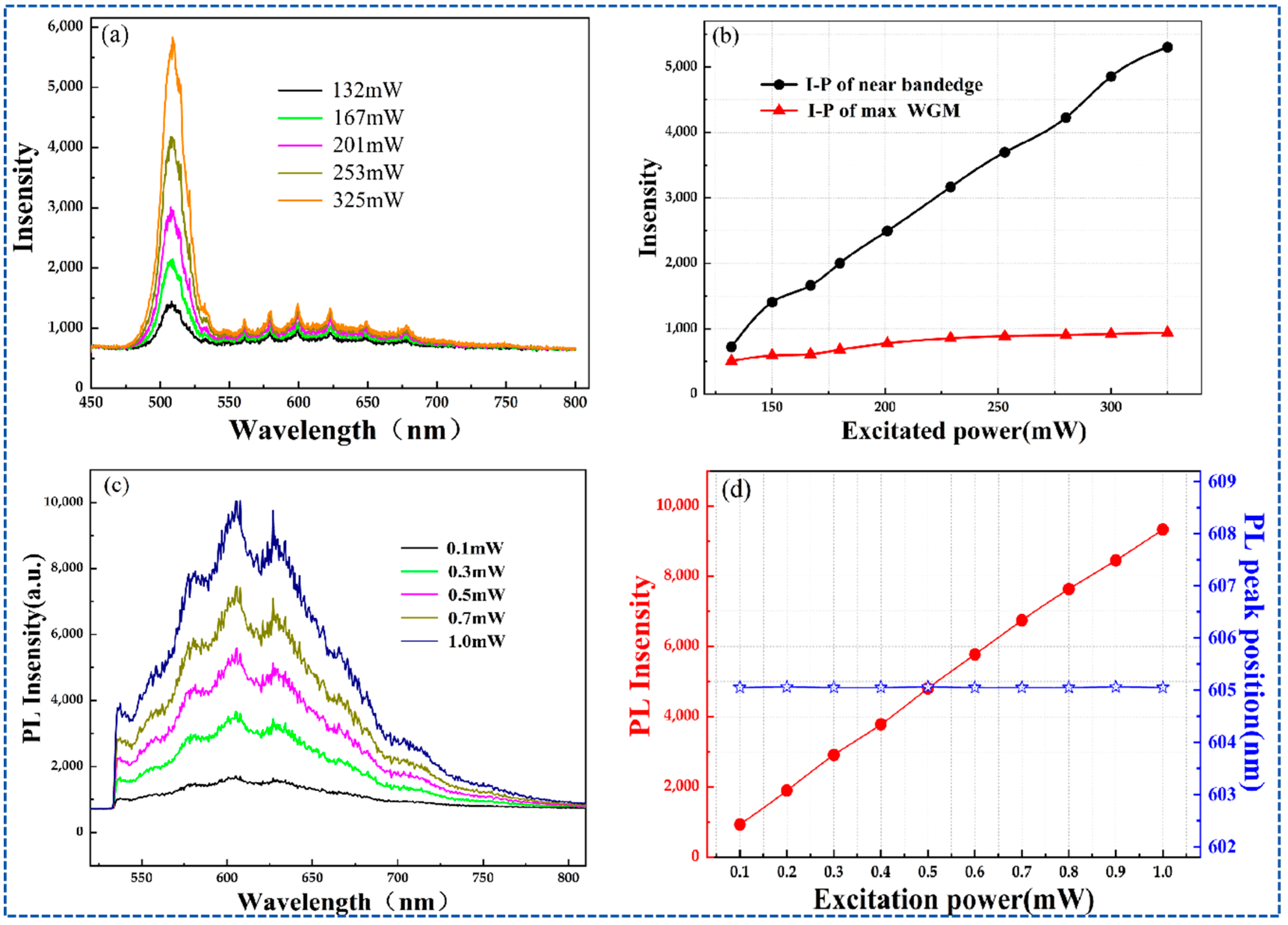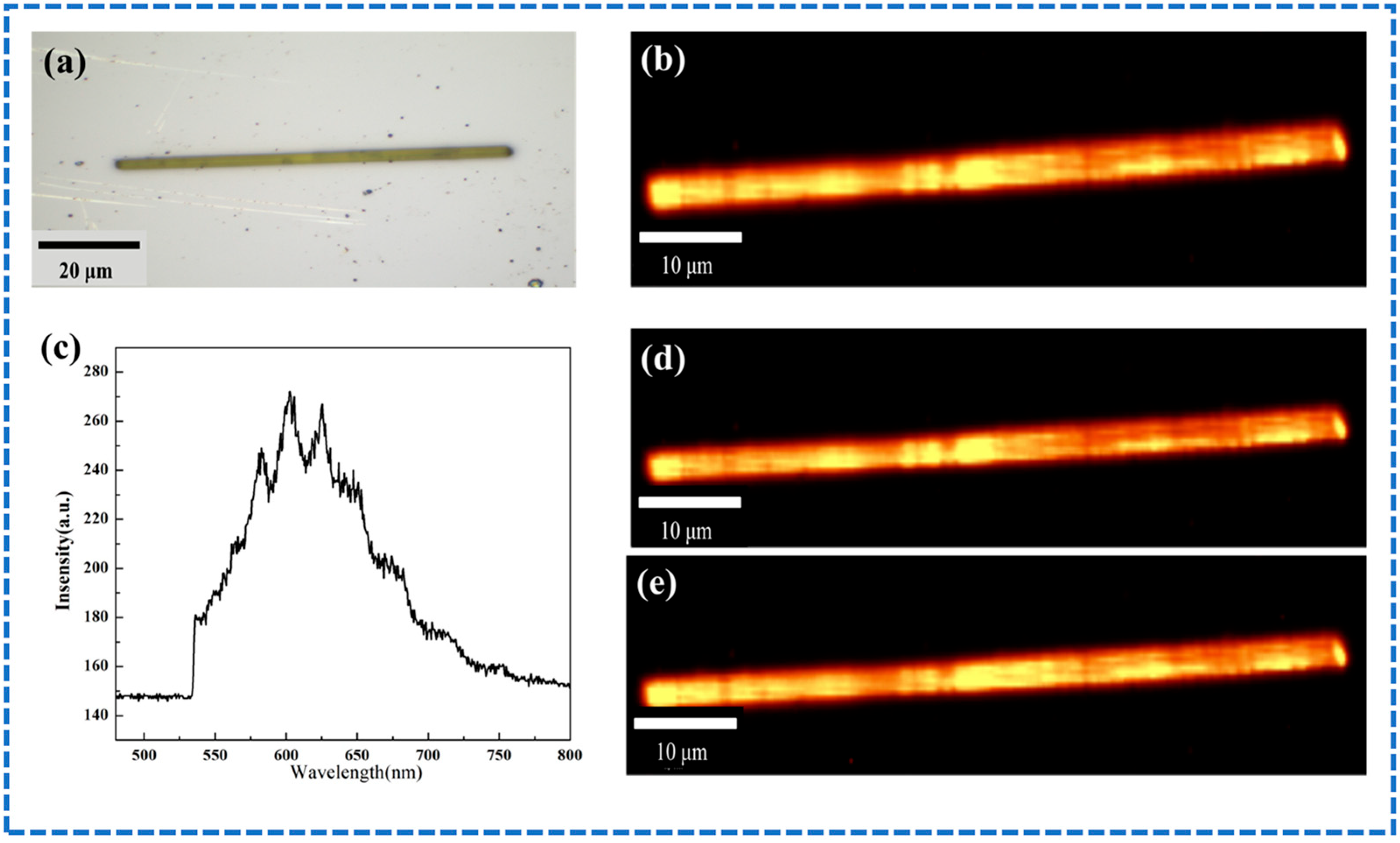Whispering Gallery Modes in a Micro-Cavity Within a Single Sn-Doped CdS Nanowire Featuring a Regular Hexagonal Cross-Section
Abstract
1. Introduction
2. Materials and Methods
3. Results and Discussion
4. Conclusions
Author Contributions
Funding
Data Availability Statement
Acknowledgments
Conflicts of Interest
References
- Qian, F.; Li, Y.; Gradečak, S.; Park, H.G.; Dong, Y.; Ding, Y.; Wang, Z.L.; Lieber, C.M. Multi-quantum-well nanowire heterostructures for wavelength-controlled lasers. Nat. Mater. 2008, 7, 701–706. [Google Scholar] [CrossRef] [PubMed]
- No, Y.-S. Electrically Driven Micro- and Nano-Scale Semiconductor Light Sources. Appl. Sci. 2019, 9, 802. [Google Scholar] [CrossRef]
- Baimukhanov, Z.; Dauletbekova, A.; Junisbekova, D. Synthesis of Orthorhombic Tin Dioxide Nanowires in Track Templates. Materials 2024, 17, 1226. [Google Scholar] [CrossRef] [PubMed]
- Cao, B.; Tian, Y.; Wen, H.F.; Guo, H.; Wu, X.Y.; Li, L.; Zhang, Z.; Liu, L.; Zhu, Q.; Tang, J. Recent progress on fabrication, spectroscopy properties, and device applications in Sn-doped CdS micro-nano structures. J. Semicond. 2024, 45, 091101. [Google Scholar] [CrossRef]
- Yan, H.; Choe, H.S.; Nam, S.W.; Hu, Y.; Das, S.; Klemic, J.F.; Ellenboge, J.C.; Lieber, C.M. Programmable nanowire circuits for nanoprocessors. Nature 2011, 470, 240–244. [Google Scholar] [CrossRef] [PubMed]
- Liu, X.; Xu, P.; Wu, Y.; Yang, Z.; Meng, C.; Yang, W.; Li, J.; Wang, D.; Liu, X.; Yang, Q. Control, optimization and measurement of parameters of semiconductor nanowires lasers. Nano Energy 2015, 14, 340–354. [Google Scholar] [CrossRef]
- Friedman, R.S.; McAlpine, M.C.; Ricketts, D.S.; Ham, D.; Lieber, C.M. High-speed integrated nanowire circuits. Nature 2005, 434, 1085. [Google Scholar] [CrossRef] [PubMed]
- Sirbuly, D.J.; Law, M.; Pauzauskie, P.; Yan, H.; Maslov, A.V.; Knutsen, K.; Ning, C.Z.; Saykally, R.J.; Yang, P. Optical routing and sensing with nanowire assemblies. Proc. Natl. Acad. Sci. USA 2005, 102, 7800–7805. [Google Scholar] [CrossRef] [PubMed]
- Pan, A.; Zhou, W.; Leong, E.S.P.; Liu, R.; Chin, A.H.; Zou, B.; Ning, C.Z. Continuous alloy-composition spatial grading and superbroad wavelength-tunable nanowire lasers on a single chip. Nano Lett. 2009, 9, 784–788. [Google Scholar] [CrossRef] [PubMed]
- Zhang, M.; Wille, M.; Röder, R.; Heedt, S.; Jia, G.L. Amphoteric nature of Sn in CdS nanowires. Nano Lett. 2014, 14, 518–523. [Google Scholar] [CrossRef] [PubMed]
- Agarwal, R.; Barrelet, C.J.; Lieber, C.M. Lasing in single cadmium sulfide nanowire optical cavities. Nano Lett. 2005, 5, 917–920. [Google Scholar] [CrossRef] [PubMed]
- Liu, X.; Zhang, Q.; Xiong, Q.; Sum, T.C. Tailoring the lasing modes in semiconductor nanowire cavities using intrinsic self-absorption. Nano Lett. 2013, 13, 1080–1085. [Google Scholar] [CrossRef] [PubMed]
- Tian, Y.; Yao, S.; Zou, B. Excitation-Power-Dependent Color Tuning in a Single Sn-Doped CdS Nanowire. Molecules 2024, 29, 5389. [Google Scholar] [CrossRef] [PubMed]
- Tian, Y.; Yao, S.; Zhou, Z.; Peng, H.; Ke, B.; Zhou, W.; Zhang, Y.; Zou, B. Super-Broad-Wavelength-Range Polarization-Selective Exciton-Polariton in Sn-Doped CdS Nanowires. ACS Appl. Opt. Mater. 2023, 1, 298–305. [Google Scholar] [CrossRef]
- Zhang, L.; Zhang, Y.; Guo, Y.; Wang, Y.; Liu, R.; Chen, B.; Zhong, H.; Zou, B. Growth of CdS nanotubes and their strong optical microcavity effects. Nanoscale 2019, 11, 5325–5329. [Google Scholar] [CrossRef] [PubMed]
- Zhang, Q.; Wang, S.W.; Liu, X.; Chen, T.; Li, H.; Liang, J.; Zheng, W.; Agarwal, R.; Lu, W.; Pan, A. Low threshold, single-mode laser based on individual CdS nanoribbons in dielectric DBR microcavity. Nano Energy 2016, 30, 481–487. [Google Scholar] [CrossRef]
- Xu, T.; Lv, Q.; Li, X.; Xu, Z.; Xin, W.; Shen, X.; Guo, P.; Xiao, L. Formation of CdS/Sn Superlattice Nanowires and Room-Temperature Microcavity Stimulated Emission. ACS Appl. Nano Mater. 2025, 8, 7235–7242. [Google Scholar] [CrossRef]
- Feng, C.; Xu, Z.; Wang, X.; Yang, H.; Fu, H. Organic-nanowire–SiO2 core–shell microlasers with highly polarized and narrow emissions for biological imaging. Acs Appl. Mater. Interfaces 2017, 9, 7385–7391. [Google Scholar] [CrossRef] [PubMed]
- Che, K.-J.; Huang, Y.-Z. Mode characteristics of metallically coated square microcavity connected with an output waveguide. J. Appl. Phys. 2010, 107, 113103. [Google Scholar] [CrossRef]
- Baek, H.; Hyun, J.K.; Chung, K.; Oh, H.; Yi, G.C. Selective excitation of Fabry-Perot or whispering-gallery mode-type lasing in GaN microrods. Appl. Phys. Lett. 2014, 105, 201108. [Google Scholar] [CrossRef]
- Dai, G.; Zhang, Y.; Liu, R.; Qiang, W.; Zhang, Q.; Pan, A.; Zou, B. Visible whispering-gallery modes in ZnO microwires with varied cross sections. J. Appl. Phys. 2011, 110, 033101. [Google Scholar] [CrossRef]
- Liu, Y.; Dong, H.; Sun, S.; Liu, W.; Zhan, J.; Chen, Z.; Wang, J.; Zhang, L. Optical modulation of ZnO microwire optical resonators with a parallelogram cross-section. Nanoscale 2013, 5, 4123–4128. [Google Scholar] [CrossRef] [PubMed]
- Shang, Q.; Zhang, S.; Liu, Z.; Chen, J.; Yang, P.; Li, C.; Li, W.; Zhang, Y.; Xiong, Q.; Liu, X.; et al. Surface plasmon enhanced strong exciton–photon coupling in hybrid inorganic–organic perovskite nanowires. Nano Lett. 2018, 18, 3335–3343. [Google Scholar] [CrossRef] [PubMed]
- Takazawa, K.; Inoue, J.; Mitsuishi, K.; Takamasu, T. Fraction of a millimeter propagation of exciton polaritons in photoexcited nanofibers of organic dye. Phys. Rev. Lett. 2010, 105, 067401. [Google Scholar] [CrossRef] [PubMed]
- Zhang, Y.; Zhou, H.; Liu, S.W.; Tian, Z.R.; Xiao, M. Second-harmonic whispering-gallery modes in ZnO nanotetrapod. Nano Lett. 2009, 9, 2109–2112. [Google Scholar] [CrossRef] [PubMed]
- Tessarek, C.; Röder, R.; Michalsky, T.; Geburt, S.; Franke, H.; Schmidt-Grund, R.; Heilmann, M.; Hoffmann, B.; Ronning, C.; Grundmann, M.; et al. Improving the optical properties of self-catalyzed GaN microrods toward whispering gallery mode lasing. ACS Photonics 2014, 1, 990–997. [Google Scholar] [CrossRef]
- Czekalla, C.; Sturm, C.; Schmidt-Grund, R.; Cao, B.Q.; Lorenz, W.; Grundmann, M. Whispering gallery mode lasing in zinc oxide microwires. Appl. Phys. Lett. 2008, 92, 241102. [Google Scholar] [CrossRef]
- Nobis, T.; Kaidashev, E.M.; Rahm, A.; Lorenz, M.; Grundmann, M. Whispering gallery modes in nanosized dielectric resonators with hexagonal cross section. Phys. Rev. Lett. 2004, 93, 103903. [Google Scholar] [CrossRef] [PubMed]
- Liu, R.; Li, Z.A.; Zhang, C.; Wang, C.; Kamran, M.A.; Farle, M.; Zou, B. Single-step synthesis of monolithic comb-like CdS nanostructures with tunable waveguide properties. Nano Lett. 2013, 13, 2997–3001. [Google Scholar] [CrossRef] [PubMed]
- Wu, Y.; Yang, P. Direct observation of vapor−liquid−solid nanowire growth. J. Am. Chem. Soc. 2001, 123, 3165–3166. [Google Scholar] [CrossRef]
- Wagner, R.S.; Ellis, W.C. Vapor-Liquid-Solid mechanism of single crystal growth (New method growth catalysis from impurity whiker epitaxial large cystals). Appl. Phys. Lett. 1964, 4, 89–90. [Google Scholar] [CrossRef]
- Evans, T.J.S.; Schlaus, A.; Fu, Y.; Zhou, X.; Atallah, T.L.; Spencer, M.S.; Brus, L.E.; Jin, S.; Zhu, X.Y. Continuous-wave lasing in cesium lead bromide perovskite nanowires. Adv. Opt. Mater. 2018, 6, 1700982. [Google Scholar] [CrossRef]
- Bhowmik, A.K. Polygonal optical cavities. Appl. Opt. 2000, 39, 3071–3075. [Google Scholar] [CrossRef] [PubMed]
- Gong, S.H.; Ko, S.M.; Jang, M.H.; Cho, Y.H. Giant rabi splitting of whispering gallery polaritons in GaN/InGaN core–shell wire. Nano Lett. 2015, 15, 4517–4524. [Google Scholar] [CrossRef] [PubMed]
- Sun, L.; Sun, S.; Dong, H.; Xie, W.; Richard, M.; Zhou, L.; Dang, L.S.; Shen, X.; Chen, Z. Room temperature one-dimensional polariton condensate in a ZnO microwire. Br. J. Radiol. 2010, 67, 605–608. [Google Scholar]
- Li, Q.; Li, C.; Shang, Q.; Zhao, L.; Zhang, S.; Gao, Y.; Liu, X.; Wang, X.N.; Zhang, Q. Lasing from reduced dimensional perovskite microplatelets: Fabry-Pérot or whispering-gallery-mode? J. Chem. Phys. 2019, 151, 211101. [Google Scholar] [CrossRef] [PubMed]
- Sun, L.; Ren, M.; Liu, W.; Agarwal, R. Resolving parity and order of fabry–pérot modes in semiconductor nanostructure waveguides and lasers: Young’s interference experiment revisited. Nano Lett. 2014, 14, 6564–6571. [Google Scholar] [CrossRef] [PubMed]
- Xu, D.; Liu, W.; Zhang, S.; Shen, X.; Chen, Z. Three-dimensional confinement of polaritons in ZnO microcylinder. Opt. Express 2013, 21, 3911–3916. [Google Scholar] [CrossRef] [PubMed]
- Wang, X.; Zhang, W.; Song, G.; Zou, B.; Li, Z.; Guo, S.; Li, J.; Li, Q.; Liu, R. Visual monitoring of laser power and spot profile in micron region by a single chip of Zn-doped CdS nanobelts. RSC Adv. 2014, 4, 52550–52554. [Google Scholar] [CrossRef]
- Zheng, Q.; Zhou, W.; Peng, Y.; Yin, Y.; Zhong, M.; Zhao, Z.; Zhang, Q.; Tang, D.; Zeng, R.; Zou, B. Surface polarons and optical micro-cavity modulated broad range multi-mode emission of Te-doped CdS nanowires. Nanotechnology 2018, 29, 465709. [Google Scholar] [CrossRef] [PubMed]
- Saxena, D.; Mokkapati, S.; Parkinson, P.; Jiang, N.; Gao, Q.; Tan, H.H.; Jagadish, C. Optically pumped room-temperature GaAs nanowire lasers. Nat. Photonics 2013, 7, 963–968. [Google Scholar] [CrossRef]
- Duan, X.; Yu, H.; Agarwal, R.; Lieber, C.M. Single-nanowire electrically driven lasers. Nature 2003, 421, 241–245. [Google Scholar] [CrossRef] [PubMed]
- Zhang, L.; Liu, R.; Zou, B. Sn-Doped CdS Nanowires with Low-Temperature Lasing by CW-Laser Excitation. ACS Appl. Electron. Mater. 2019, 2, 282–289. [Google Scholar] [CrossRef]
- Geburt, S.; Thielmann, A.; Röder, R.; Borschel, C.; McDonnell, A.; Kozlik, M.; Kühnel, J.; Sunter, K.A.; Capasso, F.; Ronning, C. Low threshold room-temperature lasing of CdS nanowires. Nanotechnology 2012, 23, 365204. [Google Scholar] [CrossRef] [PubMed]
- Li, Y.; Dai, G.; Zhou, C.; Zhang, Q.; Wan, Q.; Fu, L.; Zhang, J.; Liu, R.; Cao, C.; Pan, A.; et al. Formation and optical properties of ZnO: ZnFe2O4 superlattice microwires. Nano Res. 2010, 3, 326–338. [Google Scholar] [CrossRef]
- Dai, G.; Zou, B.; Wang, Z. Preparation and periodic emission of superlattice CdS/CdS: SnS2 microwires. J. Am. Chem. Soc. 2010, 132, 12174–12175. [Google Scholar] [CrossRef] [PubMed]





Disclaimer/Publisher’s Note: The statements, opinions and data contained in all publications are solely those of the individual author(s) and contributor(s) and not of MDPI and/or the editor(s). MDPI and/or the editor(s) disclaim responsibility for any injury to people or property resulting from any ideas, methods, instructions or products referred to in the content. |
© 2025 by the authors. Licensee MDPI, Basel, Switzerland. This article is an open access article distributed under the terms and conditions of the Creative Commons Attribution (CC BY) license (https://creativecommons.org/licenses/by/4.0/).
Share and Cite
Yu, J.; Li, Z.; Tian, Y.; Li, F.; Li, T.; Lei, C.; Liang, T. Whispering Gallery Modes in a Micro-Cavity Within a Single Sn-Doped CdS Nanowire Featuring a Regular Hexagonal Cross-Section. Crystals 2025, 15, 658. https://doi.org/10.3390/cryst15070658
Yu J, Li Z, Tian Y, Li F, Li T, Lei C, Liang T. Whispering Gallery Modes in a Micro-Cavity Within a Single Sn-Doped CdS Nanowire Featuring a Regular Hexagonal Cross-Section. Crystals. 2025; 15(7):658. https://doi.org/10.3390/cryst15070658
Chicago/Turabian StyleYu, Jiangang, Ziwei Li, Ye Tian, Fengchao Li, Tengteng Li, Cheng Lei, and Ting Liang. 2025. "Whispering Gallery Modes in a Micro-Cavity Within a Single Sn-Doped CdS Nanowire Featuring a Regular Hexagonal Cross-Section" Crystals 15, no. 7: 658. https://doi.org/10.3390/cryst15070658
APA StyleYu, J., Li, Z., Tian, Y., Li, F., Li, T., Lei, C., & Liang, T. (2025). Whispering Gallery Modes in a Micro-Cavity Within a Single Sn-Doped CdS Nanowire Featuring a Regular Hexagonal Cross-Section. Crystals, 15(7), 658. https://doi.org/10.3390/cryst15070658






